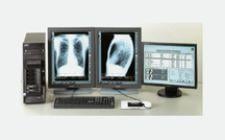
Madison Medical Center, Fredericktown, MO.
As one of the first hospitals in Missouri to be built under the Hill Burton Act of 1946, Madison Medical Center serves the rural communities of Madison County in the southeastern corner of the state. Since 1961, the facility has been the only local hospital that provides accessible, quality healthcare. In 2000, Madison Medical Center gained designation as a Critical Access Hospital licensed for 25 beds.
Providing radiology services and coverage in rural facilities like Madison Medical Center is, quite often, a “life or death” necessity; the likelihood of another provider within any reasonable, safe distance is slim to none. Unfortunately, it is these facilities that can often least afford advanced imaging and information technology that can greatly enhance the quality of patient care.
The Missouri Foundation for Health – created in January 2000 as part of a negotiated agreement between Blue Cross/Blue Shield of Missouri (BCBSMo), the Missouri Department of Insurance and the Missouri Attorney General – is charged with the mission to help communities “achieve equal access to quality health services.” As one of the largest healthcare foundations in the country, the foundation regularly provides grants to address the needs of the underinsured, uninsured and underserved populations in Missouri.
In 2004, Madison Medical Center applied and received a grant that enabled the facility to embark on a digital infrastructure for its radiology department. “Without the grant, we would not have been able to pursue PACS,” said Lisa Twidwell, CFO, Madison Medical Center.
“The most important factor for implementing PACS was to increase the radiologist’s coverage at night – it was really all about providing quality patient care,” Twidwell explained. With one radiologist, nighttime radiology coverage for the facility’s 24-hour emergency room was taking its toll. The facility knew it must implement a solution with the grant funding to push images to the radiologist’s home during off hours.
This further drove the selection criteria for Twidwell and her staff. First, the PACS must be Web-based to enable the distribution of images anytime, anywhere. Second, user intervention must be minimal with a simplistic, easy-to-use interface for technologists and clinicians. Third, the system needed to include a RIS for order entry and scheduling. Fourth, the cost and implementation must be within the realm of the grant; no additional funding for overages or other unforeseen events was available.
“Support was also a key factor,” Twidwell added. Limited IT resources dictated a high-quality, reliable system that was also easy to use.
With an initial list of seven prospective vendors, Twidwell began the information gathering process. She interviewed vendors and evaluated system features. Subsequent discussions with end-users regarding features, usability, reliability and downtime, as well as the seamless nature of vendor-installed upgrades, provided Twidwell with a broad view of system and vendor performance.
“Cost was really a major factor that scaled down the number of vendors,” Twidwell said. Some vendors dropped out simply because they couldn’t provide the system within the cost-constraints of the grant. One-on-one vendor visits offered a hands-on demonstration and trial use of the workstation. Twidwell, the radiologist, a technologist and the hospital administrator were all involved in the process. Quality assurance was performed by a hospital laboratory employee to provide an “outsider’s view” of the workstation.
After a thorough review, BRIT Systems was chosen as Madison Medical Center’s preferred PACS/RIS vendor. BRIT’s PACS/RIS solution also eliminates the expense of integrating two systems and further reduces overall cost with a single platform.
The first step was the implementation of a new CR one month before the PACS installation. In fact, throughout that preceding month, the staff performed a series of tasks aimed at prepping the department for migration to an electronic infrastructure. Each modality vendor was contacted to set-up the “to/from” designations for PACS, as well as ensure each system could handle two-way (push and pull) communication from the PACS.
In March 2005, BRIT installed the PACS/RIS and went live, in a transition that Twidwell called “very smooth.” All modalities were converted at one time, while the PACS communication testing was completed.
“Preplanning definitely played a major role in enabling BRIT to seamlessly connect to each modality during a smooth implementation,” Twidwell explained. She suggests that other facilities like hers – particularly small, rural medical centers that don’t have deep resources – take sufficient preparation time between the final vendor selection and implementation.
All images are currently being stored on a short-term archive provided and supported by BRIT, although Twidwell expects to upgrade the archive in the near future. Most important for Twidwell and the radiologist is that all modalities – CT, MRI, CR, ultrasound and nuclear medicine – are read on one workstation, thanks to the power of BRIT Vision, BRIT’s Linux-based multimodality workstation. This facilitates the effectiveness and efficiency of Madison Medical Center’s sole radiologist and enables him to provide the speed and quality of care comparable to most major urban healthcare facilities.
“Since we’ve installed PACS, the patient has been the biggest benefactor,” said Twidwell. Most important, the center achieved its primary goal of providing faster, more efficient nighttime reading services to the local community.



 November 12, 2025
November 12, 2025 









